Marshalltown Community College
Las últimas cargas en Marshalltown Community College. ¿Buscando notas en Marshalltown Community College? Tenemos muchas notas, guias de estudio y notas de estudio disponsible para tu escuela.
-
75
- 0
-
1
All courses for Marshalltown Community College
-
NURSING PNN101 2
-
SOC 101 2
Últimos notas y resúmenes Marshalltown Community College
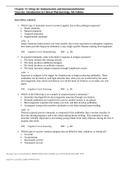
1. Which type of immunity serves to protect against day-to-day pathogen exposure? a. Innate immunity b. Natural immunity c. Acquired immunity d. Supplemental immunity ANS: A Innate immunity helps protect you from smaller day-to-day exposures to pathogenic organism but cannot provide long-term immunity to any single specific disease-causing microorganism. DIF: Cognitive Level: Remembering REF: p. 280 2. In acquired immunity, what is the body’s response to antigen exposure? a. The body...
- Examen
- • 6 páginas's •
-
Marshalltown Community College•NURSING MISC
Vista previa 2 fuera de 6 páginas
1. Which type of immunity serves to protect against day-to-day pathogen exposure? a. Innate immunity b. Natural immunity c. Acquired immunity d. Supplemental immunity ANS: A Innate immunity helps protect you from smaller day-to-day exposures to pathogenic organism but cannot provide long-term immunity to any single specific disease-causing microorganism. DIF: Cognitive Level: Remembering REF: p. 280 2. In acquired immunity, what is the body’s response to antigen exposure? a. The body...
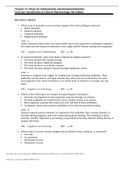
1. Which type of immunity serves to protect against day-to-day pathogen exposure? a. Innate immunity b. Natural immunity c. Acquired immunity d. Supplemental immunity ANS: A Innate immunity helps protect you from smaller day-to-day exposures to pathogenic organism but cannot provide long-term immunity to any single specific disease-causing microorganism. DIF: Cognitive Level: Remembering REF: p. 280 2. In acquired immunity, what is the body’s response to antigen exposure? a. The body...
- Examen
- • 6 páginas's •
-
Marshalltown Community College•NURSING MISC
Vista previa 2 fuera de 6 páginas
1. Which type of immunity serves to protect against day-to-day pathogen exposure? a. Innate immunity b. Natural immunity c. Acquired immunity d. Supplemental immunity ANS: A Innate immunity helps protect you from smaller day-to-day exposures to pathogenic organism but cannot provide long-term immunity to any single specific disease-causing microorganism. DIF: Cognitive Level: Remembering REF: p. 280 2. In acquired immunity, what is the body’s response to antigen exposure? a. The body...
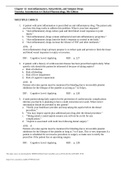
1. A patient with joint inflammation is prescribed an anti-inflammatory drug. The patient asks you how this drug works to address this problem. What is your best response? a. “Anti-inflammatory drugs reduce pain and limit blood vessel responses to joint injury.” b. “Anti-inflammatory drugs contain antibacterial and anti-inflammatory properties.” c. “Anti-inflammatory drugs limit the body’s response to cortisol in the body.” d. “Anti-inflammatory drugs increase the release o...
- Examen
- • 9 páginas's •
-
Marshalltown Community College•NURSING MISC
Vista previa 2 fuera de 9 páginas
1. A patient with joint inflammation is prescribed an anti-inflammatory drug. The patient asks you how this drug works to address this problem. What is your best response? a. “Anti-inflammatory drugs reduce pain and limit blood vessel responses to joint injury.” b. “Anti-inflammatory drugs contain antibacterial and anti-inflammatory properties.” c. “Anti-inflammatory drugs limit the body’s response to cortisol in the body.” d. “Anti-inflammatory drugs increase the release o...
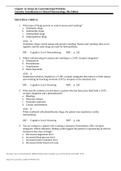
Chapter 13: Drugs for Gastrointestinal Problems Visovsky: Introduction to Clinical Pharmacology, 9th Edition MULTIPLE CHOICE 1. What types of drugs prevent or control nausea and vomiting? a. Antiemetic drugs b. Antimotility drugs c. Antidiarrheal drugs d. Antipropulsion drugs ANS: A Antiemetic drugs control nausea and prevent vomiting. Nausea and vomiting often occur together, and the same drugs are used for both problems. DIF: Cognitive Level: Remembering REF: p. 242 2. Which common...
- Caso
- • 7 páginas's •
-
Marshalltown Community College•NURSING MISC
Vista previa 2 fuera de 7 páginas
Chapter 13: Drugs for Gastrointestinal Problems Visovsky: Introduction to Clinical Pharmacology, 9th Edition MULTIPLE CHOICE 1. What types of drugs prevent or control nausea and vomiting? a. Antiemetic drugs b. Antimotility drugs c. Antidiarrheal drugs d. Antipropulsion drugs ANS: A Antiemetic drugs control nausea and prevent vomiting. Nausea and vomiting often occur together, and the same drugs are used for both problems. DIF: Cognitive Level: Remembering REF: p. 242 2. Which common...
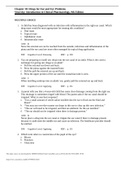
Chapter 18: Drugs for Ear and Eye Problems Visovsky: Introduction to Clinical Pharmacology, 9th Edition MULTIPLE CHOICE 1. A child has been diagnosed with an infection with inflammation in the right ear canal. Which drug route would be most appropriate for treating this condition? a. Oral route b. Topical route c. Ophthalmic route d. Intramuscular route ANS: B Since the external ear can be reached from the outside, infections and inflammation of the pinna and the ear canal are most of...
- Examen
- • 6 páginas's •
-
Marshalltown Community College•NURSING MISC
Vista previa 2 fuera de 6 páginas
Chapter 18: Drugs for Ear and Eye Problems Visovsky: Introduction to Clinical Pharmacology, 9th Edition MULTIPLE CHOICE 1. A child has been diagnosed with an infection with inflammation in the right ear canal. Which drug route would be most appropriate for treating this condition? a. Oral route b. Topical route c. Ophthalmic route d. Intramuscular route ANS: B Since the external ear can be reached from the outside, infections and inflammation of the pinna and the ear canal are most of...
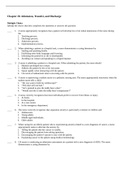
Chapter 20. Admission, Transfer, and Discharge Multiple Choice Identify the choice that best completes the statement or answers the question. ____ 1. A nurse appropriately recognizes that a patient will develop his or her initial impression of the nurse during the 1. Teaching process. 2. Discharge process. 3. Admission process. 4. Implementation process. ____ 2. When admitting a patient to a hospital unit, a nurse demonstrates a caring demeanor by 1. Smiling and speaking kindly. 2. Ex...
- Examen
- • 21 páginas's •
-
Marshalltown Community College•NURSING MISC
Vista previa 3 fuera de 21 páginas
Chapter 20. Admission, Transfer, and Discharge Multiple Choice Identify the choice that best completes the statement or answers the question. ____ 1. A nurse appropriately recognizes that a patient will develop his or her initial impression of the nurse during the 1. Teaching process. 2. Discharge process. 3. Admission process. 4. Implementation process. ____ 2. When admitting a patient to a hospital unit, a nurse demonstrates a caring demeanor by 1. Smiling and speaking kindly. 2. Ex...
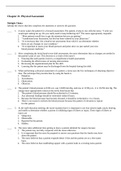
Chapter 21. Physical Assessment Multiple Choice Identify the choice that best completes the statement or answers the question. ____ 1. A nurse wakes the patient for a focused assessment. The patient, trying to rest, tells the nurse, “I wish you would quit waking me up. Do you really need to keep bothering me?” The nurse appropriately responds: 1. “Most patients would love to get the attention that you are getting.” 2. “I understand your frustration, but this has been ordered by y...
- Examen
- • 30 páginas's •
-
Marshalltown Community College•NURSING MISC
Vista previa 3 fuera de 30 páginas
Chapter 21. Physical Assessment Multiple Choice Identify the choice that best completes the statement or answers the question. ____ 1. A nurse wakes the patient for a focused assessment. The patient, trying to rest, tells the nurse, “I wish you would quit waking me up. Do you really need to keep bothering me?” The nurse appropriately responds: 1. “Most patients would love to get the attention that you are getting.” 2. “I understand your frustration, but this has been ordered by y...
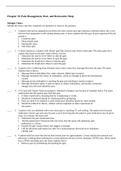
Multiple Choice Identify the choice that best completes the statement or answers the question. ____ 1. A patient who had an amputation just below the knee several days ago expresses confusion about why a foot that has been amputated is still causing intense pain. A nurse explains that the type of pain experienced by the patient is 1. Cutaneous pain. 2. Deep somatic pain. 3. Neuropathic pain. 4. Soft-tissue pain. ____ 2. A nurse explains to a patient with chronic pain that exercise may r...
- Examen
- • 15 páginas's •
-
Marshalltown Community College•NURSING MISC
Vista previa 2 fuera de 15 páginas
Multiple Choice Identify the choice that best completes the statement or answers the question. ____ 1. A patient who had an amputation just below the knee several days ago expresses confusion about why a foot that has been amputated is still causing intense pain. A nurse explains that the type of pain experienced by the patient is 1. Cutaneous pain. 2. Deep somatic pain. 3. Neuropathic pain. 4. Soft-tissue pain. ____ 2. A nurse explains to a patient with chronic pain that exercise may r...
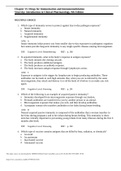
1. Which type of immunity serves to protect against day-to-day pathogen exposure? a. Innate immunity b. Natural immunity c. Acquired immunity d. Supplemental immunity ANS: A Innate immunity helps protect you from smaller day-to-day exposures to pathogenic organism but cannot provide long-term immunity to any single specific disease-causing microorganism. DIF: Cognitive Level: Remembering REF: p. 280 2. In acquired immunity, what is the body’s response to antigen exposure? a. The body...
- Examen
- • 6 páginas's •
-
Marshalltown Community College•NURSING PNN101
Vista previa 2 fuera de 6 páginas
1. Which type of immunity serves to protect against day-to-day pathogen exposure? a. Innate immunity b. Natural immunity c. Acquired immunity d. Supplemental immunity ANS: A Innate immunity helps protect you from smaller day-to-day exposures to pathogenic organism but cannot provide long-term immunity to any single specific disease-causing microorganism. DIF: Cognitive Level: Remembering REF: p. 280 2. In acquired immunity, what is the body’s response to antigen exposure? a. The body...
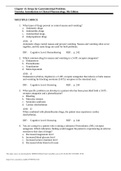
1. What types of drugs prevent or control nausea and vomiting? a. Antiemetic drugs b. Antimotility drugs c. Antidiarrheal drugs d. Antipropulsion drugs ANS: A Antiemetic drugs control nausea and prevent vomiting. Nausea and vomiting often occur together, and the same drugs are used for both problems. DIF: Cognitive Level: Remembering REF: p. 242 2. Which common drug for nausea and vomiting is a 5-HT3 receptor antagonist? a. Ondansetron b. Promethazine c. Scopolamine d. Metoclopramid...
- Examen
- • 7 páginas's •
-
Marshalltown Community College•NURSING PNN101
Vista previa 2 fuera de 7 páginas
1. What types of drugs prevent or control nausea and vomiting? a. Antiemetic drugs b. Antimotility drugs c. Antidiarrheal drugs d. Antipropulsion drugs ANS: A Antiemetic drugs control nausea and prevent vomiting. Nausea and vomiting often occur together, and the same drugs are used for both problems. DIF: Cognitive Level: Remembering REF: p. 242 2. Which common drug for nausea and vomiting is a 5-HT3 receptor antagonist? a. Ondansetron b. Promethazine c. Scopolamine d. Metoclopramid...
